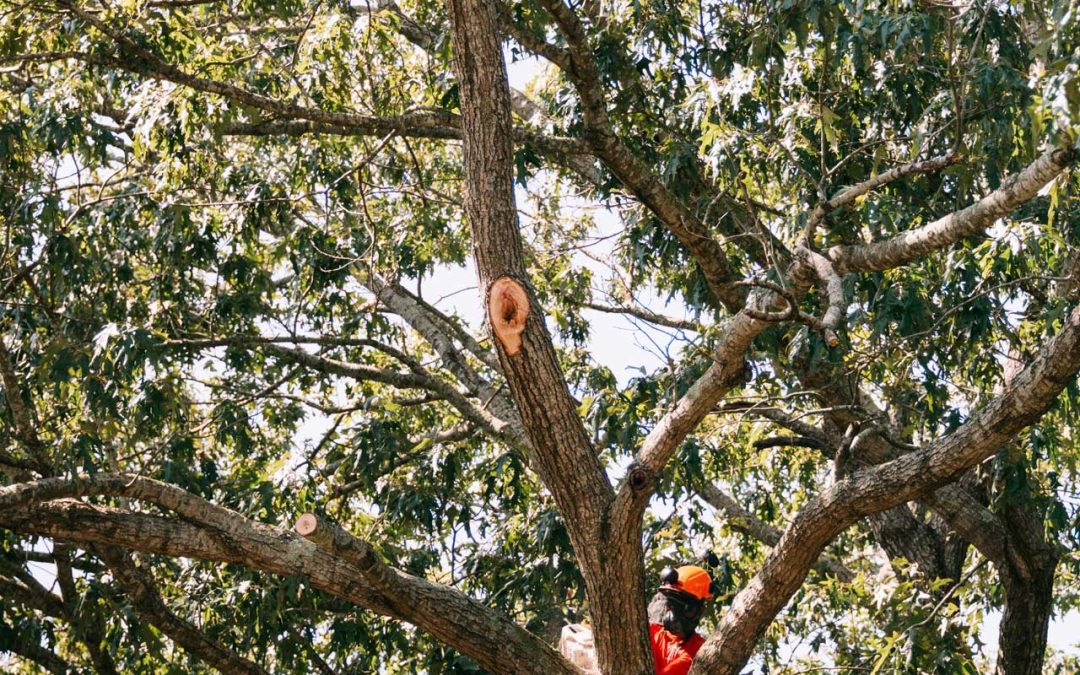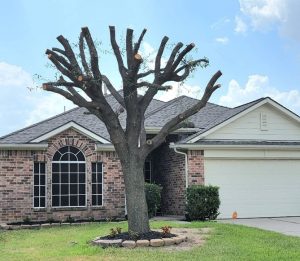What is tree topping?
Tree topping is an aggressive pruning approach that compromises your tree’s health and structure, making them weaker. It involves trimming back large branches or leads of your tree and may also involve cutting the entire top of your tree in hopes of reducing the height of the tree. It is a much faster way to trim a tree, but like most events, faster is not always better. Tree topping, also known as “hat-racking” or “heading” often leads the tree looking less than appealing. It leaves the tree with ugly stubs or ends of the leads and often takes years to grow back to the tree’s past appealing appearance. Below is a picture of a tree that has been topped. You may often see trees that have been topped to avoid touching powerlines or homeowners that are scared limbs may fall during a storm. It is also much cheaper than other pruning methods because it is much quicker. Most customers that have their trees topped do not know that it puts the tree in danger of dying. Tree topping puts the tree at a much higher risk of developing disease, bark damage, root death, structural loss, and pest problems. It makes the tree have a much harder time making food, protecting itself from damaging UV rays, adapting to temperature changes during the summer and winter, and not to mention, looking beautiful. While tree topping is cheaper than additional pruning methods, it often leads to becoming more costly overtime because you have to maintenance the tree more frequently, and often the trees die, and you must remove them entirely.
What can I do instead of topping my tree?
There are numerous ways to afford tree topping. The first question is what are you trying to do or why are you topping the tree in the first place? Are you trying to decrease the size of the tree? Or are you worried about limbs falling during a storm? Is your tree blocking a view that you would like to be able to see better? The second step is removing any branches, leads, or limbs that may be harming your tree. Any dead or damaged limbs pose a risk to the tree itself if those limbs decide to fall, it could take more of the tree than you want. Also having dead limbs on the tree is dangerous because the tree is trying to provide for said limb. If your tree has any diseased branches, this poses a huge risk to the tree because the disease will spread to the entire tree and eventually kill the tree which leaves you with an even bigger problem-removing the dead tree. If your tree has any of these dead, damaged, or diseased limbs, it is best to cut them off at the trunk. Your tree also may have branches you’d like to remove because they are overhanging a pool or near a structure like a house or shed. Depending on your preference, you may want these limbs just trimmed. However, this can be very costly, and we do not recommend this. The limbs will eventually grow back leaving you with paying for this work numerous times to keep it trimmed to your liking. We recommend pruning the limbs or leads completely down to the trunk or at the collar, so your tree can focus on growing in the other safer directions. Trimming at the collar will allow the trunk to grow healthy, covering the cut instead of leaving the cut open for disease and pest.
Another type of pruning is crown thinning. This is the process of selectively removing branches to increase light and reduce the force on the tree from wind. Removing certain branches of your tree helps wind come through the tree, and this reduces the risk of your tree falling or limbs breaking off during a storm.
Crown reduction is also another type of pruning method, and this is often what the client wants when they decide to “top” their trees. Crown reduction is the process of reducing the overall size of a tree by trimming selective higher branches. This usually does not involve taking down huge branches, instead it involves taking down numerous smaller branches that are higher up in the tree. Yes, this may be a more costly way to trim your tree; however, in the long run it is the more cost-effective option because it does not put your tree at risk of dying like tree topping does. You could say the opposite of crown reduction is crown raising. This involves trimming the lower branches of your tree that risk touching your car or in the line of humans walking like over sidewalks. These limbs have grown so large that they are lower than you would like them to be. Usually if you want to do this then you have no problem with how large your tree is getting. If this is the case then we recommend trimming these branches or limbs back to the trunk, so you do not need to keep trimming them. This makes it a much more cost-effective way to trimming the lower limbs of your tree because it only needs to be done once.
Understanding how to currently trim your tree is very important to the overall health and appearance of your tree. It is best to let a well-known professional handle the pruning of your tree to ensure its survival. Pruning your tree promotes growth of healthy and larger branches, helping to ensure your tree is growing strong. It helps your tree handle heavy weather conditions and limits the risk of them falling or becoming damaged during storms. If your tree is a fruit producing tree, trimming the dead or unhealthy branches will promote fruit growth and the growth of new spurs. Pruning helps your tree live a long and healthy life and is essential to maintaining a healthy tree.




